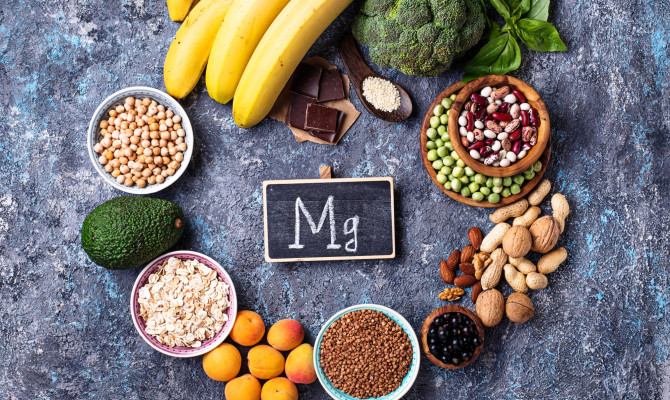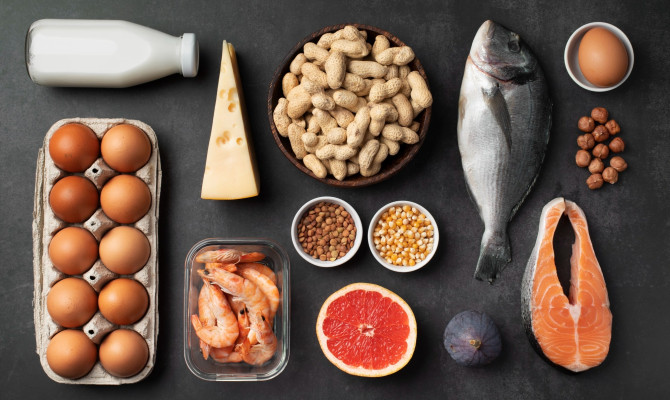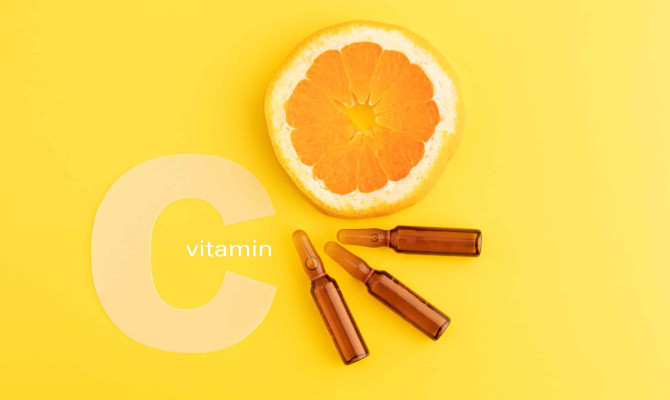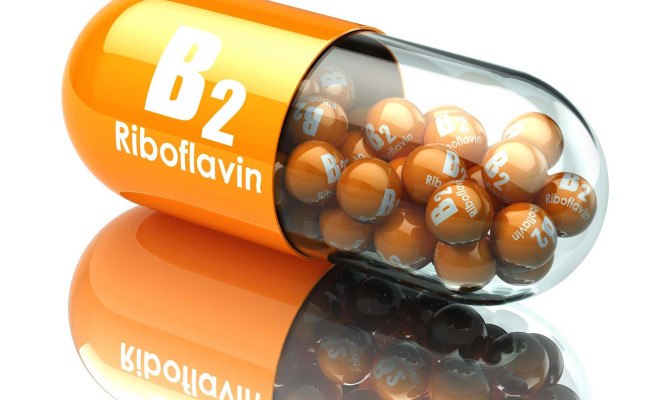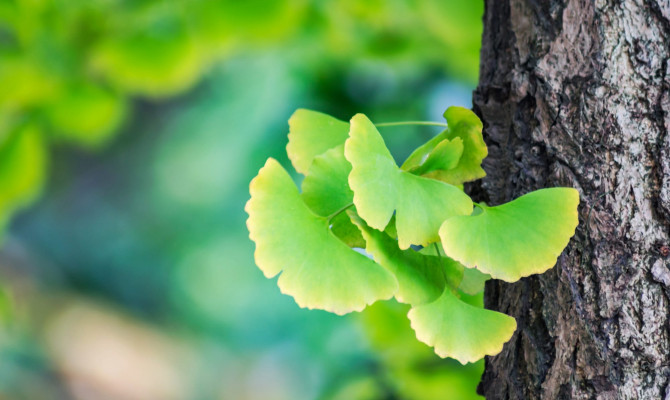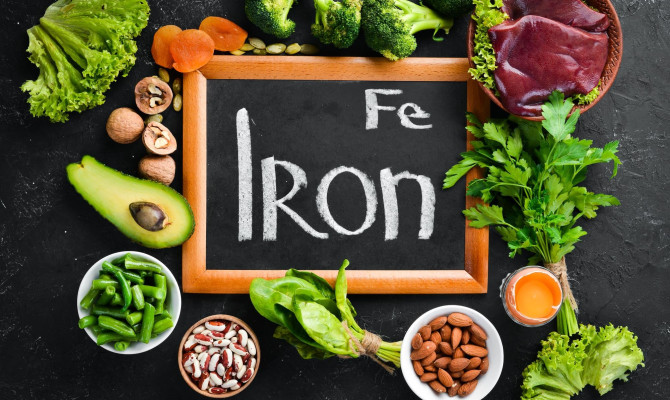Exploring the Health benefits of Red Yeast Rice

- Red Yeast Rice
- 17 Aug 2023
Overview
What is Red Yeast Rice?
Red yeast rice is obtained by growing red yeast (Monascus purpureus) on cooked white rice kernels. The fermented rice appears reddish-purple due to yeast’s pigmentation capability.
In addition to the color, the yeast produces a substance known as monacolin K which is chemically similar to the active ingredient of the prescription drug Statin, a cholesterol-lowering medication. However, the composition of the red yeast rice differs depending on the yeast strain used and the fermentation conditions.
In Asian counties, red yeast rice is used as a food and medicinal product. Today, red yeast rice is marketed as an over-the-counter supplement to reduce cholesterol and improve health. Due to its monacolin K content, the FDA (the Food and Drug Administration, United States) considered red yeast rice a drug rather than a supplement.

Facts about Red Yeast Rice
- Red Yeast Rice is also known as Monascus fermented rice and Koji (in Japanese)
- Red Yeast Rice is the chief ingredient in traditional Chinese medicines
- In China and Japan, it is used as a food colorant and flavoring agent and in food preservation, such as meat and fish.
- Red Yeast Rice is utilized as a dietary supplement in Western countries
- China is the world’s chief producer of Red Yeast Rice 1Overview| Researched based study from Nccih.nih.gov
Health Benefits
Health Benefits of Red Yeast Rice
Red Yeast Rice has the following health benefits:
- Improves the heart health
- Reduces inflammation
- Reduces cancer risk
- Decreases metabolic syndrome risk
Improves the heart health
- Red Yeast Rice reduces the level of total cholesterol
- It reduces blood pressure and decreases the risk of heart diseases 2Health benefits| Researched based study from Nlm.nih.gov
Reduces inflammation
- Red Yeast Rice decreases pain and swelling
- It also decreases the levels of inflammatory markers
Inflammatory markers are proteins that increase when there is inflammation in the body 3Health benefits| Researched based study from Nlm.nih.gov
Reduces cancer risk
- Red Yeast Rice decreases the abnormal cell growth
- In animal studies, the Red Yeast Rice powder supplement decreases tumor volume in mice with prostate cancer. However, more research is required to prove the effect of Red Yeast Rice on human cancer 4Health benefits| Researched based study from Nlm.nih.gov
Decreases metabolic syndrome risk
- Metabolic syndromes increase the risk of chronic diseases like blood sugar, blood pressure, and heart disease.
- Red Yeast Rice increases insulin sensitivity and decreases the blood sugar level.
- It also regulates the body’s blood pressure level
- It reduces the risk of chronic diseases 5Health benefits| Researched based study from Nlm.nih.gov
Formulations
Formulations of Red Yeast Rice
The Red Yeast Rice supplements can be availed online or from any health stores or pharmacies.
Red Yeast Rice is available in the following forms:
Extract form
- It is the powdered form of red yeast rice in alcohol or water
Tablet form
- It is the solid form of red yeast rice that one can swallow
Capsule form
- It is the powdered form of red yeast rice enclosed in a gelatinous shell
Tablet/Capsule in combination with other ingredients
- Red yeast rice is available in combination with ingredients viz; omega-3 fatty acid(healthy fats),CoQ10(antioxidant) , nattokinase (enzyme from natto; Japanese food)
Dosage
Dosage of Red Yeast Rice
People must follow the Red Yeast Rice dose mentioned in the product label or instruction guidelines.
The commonly used dosages are as follows:
- Adults-200-100 milligrams (mg) twice daily
Recommended dose (as per most supplement brands)
- Adults-1200-2400 mg daily in divided doses. However, one must know the monacolin K content in the red yeast rice supplement. Many manufacturers do not show the monacolin K content on the product label due to fear of action from the FDA.
- One must consult a healthcare provider to know the best dose for Red Yeast Rice.
- Red Yeast Rice containing significant monacolin –K is considered an unapproved illegal drug 6Dosage| Researched based study from Sciencedirect.com
Select products that have certified good manufacturing practices (CGMP)The supplements must be third-party tested for the ingredients and purity. It provides label honesty and contamination-free product.
Side effects
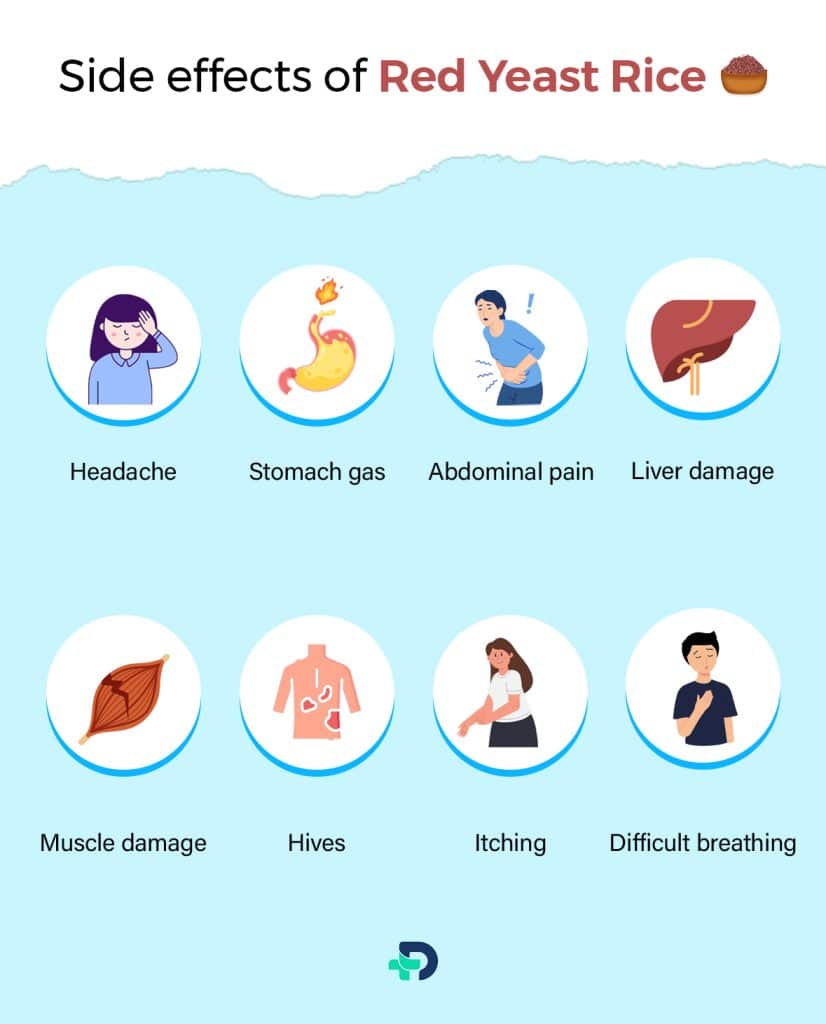
Side effects of Red Yeast Rice
Most people can tolerate Red Yeast Rice when taken by mouth for up to four and a half years. However, some people might experience the following side effects:
- Headache
- Stomach gas
- Heartburn
- Abdominal pain
- Lightheadedness
Severe side effects
Severe side effects are possible as it contains the same ingredient as the prescription drug lovastatin. Some of them are as follows:
- Liver damage
- Muscle damage
- Severe muscle pain
- Hives
- Itching
- Swelling in the mouth, lips, tongue, and throat
- Difficult breathing 7Side effects| Researched based study from Nlm.nih.gov
Precautions
Precautions need to take before using Red Yeast Rice
Legal position
- Red Yeast Rice has monacolin K as the active ingredient, similar to cholesterol-lowering medication. So FDA considered it a drug and has implemented strict regulations compared to other supplements.
- In 1998, the FDA took legal action against many firms that sold Red Yeast Rice containing increased amounts of monacolin K. They also noted selling the products as a supplement in the United States was illegal.
- However, Red Yeast Rice supplements are still legal; but they need to contain a negligible amount of monacolin K.
FDA warnings
- While using Red Yeast Rice, people might have severe side effects of statin medication, such as painful muscle and kidney problems.
- Monacolin K of Red Yeast Rice might interact with certain medications viz; antibiotics, antidepressants, and cholesterol-lowering medication.
- Moreover, according to the National Center for Complementary and Integrative Health, Red Yeast Rice might contain citrinin, a poisonous compound that can impair kidney functioning. Citrinin is toxin molds produce if the red yeast rice is not cautiously cultivated 8Precautions| Researched based study from Sciencedirect.com
Pregnancy & Lactation
- Research is still awaited on the long-term safe use of Red Yeast Rice
- Lactating mothers and pregnant women must avoid using Red Yeast Rice due to the lack of information on the safety and efficiency of these groups 9Precautions| Researched based study from Nlm.nih.gov
Controversies of Red Yeast Rice
- Red Yeast Rice is still sold legally in the United States as a dietary supplement, provided the manufacturers take steps to remove the monacolin K from the products.
- As dietary supplements, their formulations are still not strictly regulated.
- It isn’t easy to find out how much monacolin K is present in a particular Red Yeast Rice product as the label might not contain the exact information due to FDA action 10Precautions| Researched based study from Nlm.nih.gov
Contraindications
Who should avoid Red Yeast Rice?
- People on cholesterol-lowering medication
- One with HIV infection
- People with a mood disorder
- Those who have heart problems
- People with liver problem
- One with kidney problems
- If having thyroid problems
- People with cancer
- People with a musculoskeletal disorder
- One with serious infections
- If undergoing organ transplantation surgery
- People with alcohol use disorder (addicted to alcohol) 8Contraindications| Researched based study from Sciencedirect.com
Interactions
Interactions of Red Yeast Rice
Cholesterol-lowering medication (Statin)
- Red Yeast Rice contains a similar active ingredient present in the Statin drug.
- So taking Red Yeast Rice and cholesterol lowering medication together might increase the risk of side effects.
Hepatoxic drugs
- Hepatoxic drugs are medications that harm the liver.
- Red Yeast Rice might also harm the liver. So, taking Red Yeast Rice and hepatoxic drugs together might increase the risk of liver damage.
Gemfibrozil
- Gemfibrozil might affect the muscles.
- Red Yeast Rice might also affect the muscles. So, taking Red Yeast Rice and Gemfibrozil together might increase the risk of muscle damage.
Cytochrome P450 3A4 inhibitors
- Cytochrome P450 3A4 inhibitors decrease the breakdown of other medications by the liver.
- Taking Red Yeast Rice and Cytochrome P450 3A4 inhibitors together might decrease the liver’s ability to break Red Yeast Rice and hence might increase the side effect of the drug.
Some other medications that can interact with Red Yeast Rice are as follows:
- Ketoconazole (antifungal drug)
- Cyclosporine (immuno-suppressive drug)
- Diclofenac(anti-inflammatory drug)
- Cimetidine (antacids)
- Erythromycin (antibiotic)
- Methotrexate (anticancer drug) 11Interactions| Researched based study from Nlm.nih.gov
Takeaway
Key Takeaways
- Red Yeast Rice is fermented rice with Monascus yeast that turns rice red and produces the compound monacolin K, with several health benefits.
- However, Red Yeast Rice has certain downsides to consider before consuming it.
- People on medication must always consult a doctor before taking Red Yeast Rice to know the correct dose and to avoid unwanted side effects.
Any feedback on this article?
 This Articles content was accurate
This Articles content was accurate Very Informative Article
Very Informative Article I have a question or a comment
I have a question or a comment
 This article contains inaccurate content
This article contains inaccurate content This article was not helpful
This article was not helpful I have a question or a comment
I have a question or a comment
We appreciate your helpful feedback!
Checkout our social pages
References
-
National Center for Complementary and Integrative Health
Red Yeast Rice: What You Need To Know | Overview
-
National Library of Medicine
The effects of red yeast rice dietary supplement on blood pressure, lipid profile, and C-reactive protein in hypertension: A systematic review | Benefits
-
National Library of Medicine
Red yeast rice repairs kidney damage and reduces inflammatory transcription factors in rat models of hyperlipidemia | Benefits
-
National Library of Medicine
hinese Red Yeast Rice Inhibition of Prostate Tumor Growth in SCID mice | Benefits
-
National Library of Medicine
A nutraceutical combination improves insulin sensitivity in patients with metabolic syndrome | Benefits
-
Science Direct
Red Yeast Rice - an overview | Dosage
-
National Library of Medicine
Red Yeast Rice | Side effects
-
Science Direct
Red Yeast Rice (Monascus purpureus)' .In: Nonvitamin and Nonmineral Nutritional Supplements | Precautions | Contraindications
-
National Library of Medicine
Mini-review: medication safety of red yeast rice products | Precautions
-
National Library of Medicine
Scientific opinion on the safety of monacolins in red yeast rice | Precautions
-
National Library of Medicine
Interaction between Red Yeast Rice and CYP450 Enzymes/P-Glycoprotein and Its Implication for the Clinical Pharmacokinetics of Lovastatin | Interactions













